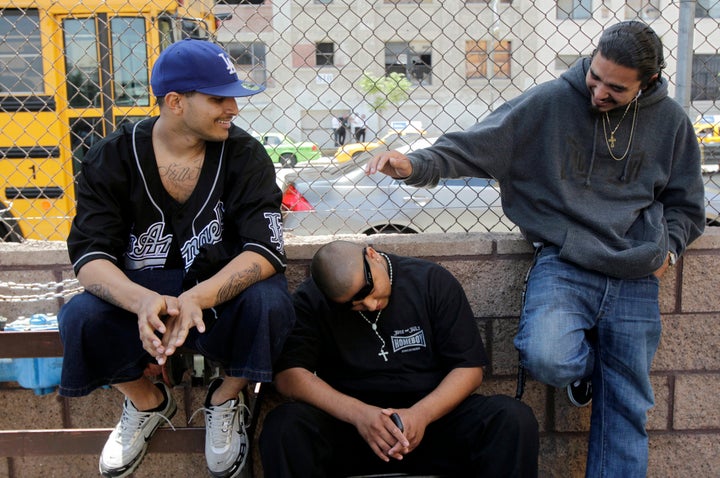
America incarcerates more youth than any other nation on Earth - at least among nations that keep such data. Within the U.S., California leads this practice where on any given day, roughly 15,000 youth reside behind bars and recidivism rates run high. That may soon change.
Last week, The Everychild Foundation, a Los Angeles women's grant making and advocacy organization serving children presented a $1-million grant to launch a new model steering youth away from the flytrap we call our juvenile justice system. Overseen by the nationally renowned Centinela Youth Services (CYS), the new Everychild Restorative Justice Center will "divert" 1,200 youth over the next three years from the "pipeline to prison" and direct them into supportive, therapeutic evidence-based services.
Instead of punitive warehousing of children in locked detention camps where little rehabilitation takes place and recidivism rates that continue into adulthood run high, the Center will offer a caring environment to assist and empower vulnerable teens. In partnership with three Inglewood Juvenile Courts, the Center will provide intensive case management with family therapy and wraparound community-based programs to reduce the number of kids attached to the juvenile justice system and hopefully to increase high school graduation rates, college readiness and employment rates. The youth will also participate in victim restitution programs to learn accountability for their actions -- a key part of the restorative justice model.
Upon satisfactory program completion, charges may be dropped, records may be sealed, and fees/penalties may be waved - crucial for children in need of a fresh start free of the psychological and societal baggage of an arrest record.
Many judges across California and the nation will be monitoring outcomes from this new center and are anxious to replicate it if successful.
But the clamor for programs like the new Everychild center gives rise to the question: why perpetuate our current juvenile incarceration system?
The practice of separating juveniles from adults in the American criminal justice system began in the nineteenth century. It was thought youth should be protected from adult offenders and that rehabilitation, not punishment, will steer them from a life of crime. Courts focused upon the legal doctrine, parens patrie, where they served as "parents" for those suffering from disabilities in the legal system - and that included children. This insight is remarkable because the courts took this approach a full century before the scientific data was available showing how the adolescent brain actually isn't fully "able", especially in the area of properly estimating consequences of actions.
By the 1960s, through a series of Supreme Court rulings, juvenile courts gradually began to resemble the adult system. Along with the 1990s hysteria that American cities were breeding "superpredator youth, states also increasingly began to try and sentence minors as adults. The entire focus then shifted away from rehabilitation and instead into "protecting society from these dangerous children".
It doesn't work. Statistics show that the vast majority of kids who break the law do not do so again. Yet when comparing youth who have committed the same level of offenses, those who become incarcerated will be more likely to re-offend than those who are not locked up. This is no shock considering the incarcerated youth have typically been housed for months in depressing facilities with other troubled kids, few of whom are receiving proper mental health assessments, therapeutic and academic services or family counseling. And it's also been shown that when youth are incarcerated as adults, their recidivism rates are even higher than if they'd been sentenced as juveniles for the same offenses.
With the exception of progressive, small cottage-system therapeutic programs such as the successful Missouri Model, incarcerated children in America are generally housed in situations that would shock even Dickens.
And all of this has helped contribute to our exploding U.S. adult prison population with an estimated $50 billion annual price tag - the 2nd largest state expenditure behind Medicaid. When other nations are using these same dollars to invest in developing the intellect of its population, we are increasingly using them to put ours further behind.
However, programs like the new Everychild model and others such as the celebrated Miami/Dade County, Florida diversion system can provide help. In Miami, over 80 percent of kids successfully complete their program with recidivism under 10% - far below that of youth in neighboring counties arrested for the same crimes. The program, now being expanded statewide, has shown tremendous cost savings due to the lower expense per child as compared to incarceration and has returned thousands of police hours to the streets as the officers are not spending time processing cases.
It's time America finally bucks the influence of those who financially benefit from an expanded prison industry as well as the "tough on crime" contingency and invest serious dollars in a "diversion track" to perfectly parallel the juvenile justice system of incarceration. It should become the "go to" system for police and prosecutors -- the "default setting" so to speak, before they even think about incarceration -- an option that should still be preserved, but only for those in need of most serious intervention in a secure environment.
All eyes are upon Los Angeles as this new program gets underway.